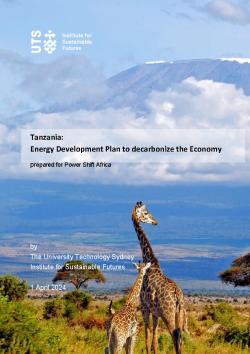The energy report ‘Tanzania: Energy Development Plan to decarbonize the Economy’ is the result of a joint research by Power Shift Africa and the University of Technology Sydney – Institute for Sustainable Futures (UTS-ISF) conducted between January 2023 and April 2024
The task was to develop comprehensive energy scenarios for Tanzania which challenges the current government and private sector plan and provides new scientific input for future policies. A focus of this work lies on the development of a 100% Renewable Energy Pathways to provide data for future National Determined Contribution (NDC) report for the United Nations Framework Convention on Climate Change.
Tanzania has an abundance of solar energy – detailed solar and wind potential assessment conducted by ISF. The solar and wind analysis maps are accessible here: Solar Potential Map, Onshore Wind Potential Map, Offshore Wind Potential Map.
The 100% Renewable Energy pathways are developed as robust, reliable and cost-effective energy plans and based on GIS based renewable energy potential analysis for solar and wind energy, hourly simulation to determine a high-level analysis of the required storage and grid expansion requirements.
The energy pathways aim to phase-out energy-related CO2 emissions as fast as possible while implementing fast and ambitious energy access programs.
The energy demand analysis is based on the following assumptions:
Economic growth to facilitate high enough to develop towards a middle-income country
Increase energy demand for services and industries
Increased decarbonised transport sector
Access to reliable and affordable energy services for all households to achieve OECD household standards by 2050.
A comprehensive energy plan for Tanzania
The One Earth Climate Model builds on Tanzania’s Rural Energy Plan and adds the transport and industry sector to this important work. The One Earth Climate Model for Tanzania consists of two scenarios: The 1.5˚C Paris aligned pathway that was developed to provide input for the Tanzania’s future National Determined (NDC) submission. A REFERENCE case shows the impact of a 15-year delay of the 1.5˚C scenario.
Energy System analysis for Tanzania
The Tanzania energy plan does not only provide a comprehensive renewable energy assessment and a detailed energy demand projection for residential buildings, the service sector, industry and mining and transport, but also includes a detailed electricity system analysis.
In the analysis, the yearly electricity demand is broken down into hourly load curves projected for 2030 and 2050. The entire power sector of the country is simulated with the generation structure and historical solar and wind data. The simulation verifies the possibility of achieving a high security of supply with 100% renewable energy generation. The consequent increased demand on the power grid transmission capacities, possible new inter-provincial connections, and/or the required expansion of energy storage facilities are all calculated.
The report finds that 100% renewable energy is not only achievable with existing technology, but cost saving and climate friendly too.
Colin Besaans, Programme Manager for African Energy Transition at Power Shift Africa says:
“Africa sits at a crossroads where many of our countries are making pivotal decisions about the future of their energy systems and development trajectories. For too long, outdated assumptions about renewable energy have been used to justify continued investments in the fossil fuel technologies that are locking us into the systems of the past. We are incredibly excited to be launching this research which makes clear that it is already possible to achieve 100% renewable energy systems that are secure, stable, cost saving, and great for the climate. We hope this can contribute to necessary conversations about how to raise African ambitions on renewable energy and avoid the maldevelopment of further fossil fuel lock-in.”
A/Prof Dr. Sven Teske, Scientific leader of the research says:
“Tanzania has significant local renewable energy resources. Our research shows that the solar and wind energy potential alone would be sufficient to supply the countries current and future electricity needs entirely. The fastest and most cost-effective way for Tanzania to become a middle-income country is through the use of domestic renewable energies. Our analysis showed that an annual investment in new power generation capacities of around US$6.5 billion is sufficient until 2050 and can be fully refinanced by savings in imported fossil fuels. The international community should provide Tanzania with sufficient financing.”
Download the report
Tanzania: Energy Development Plan to decarbonize the Economy (2024) (Report)
Researchers: Sven Teske, Maartje Feenstra, Saori Miyake, Jonathan Rispler, Sarah Niklas, Ibrahim Ibrahim

